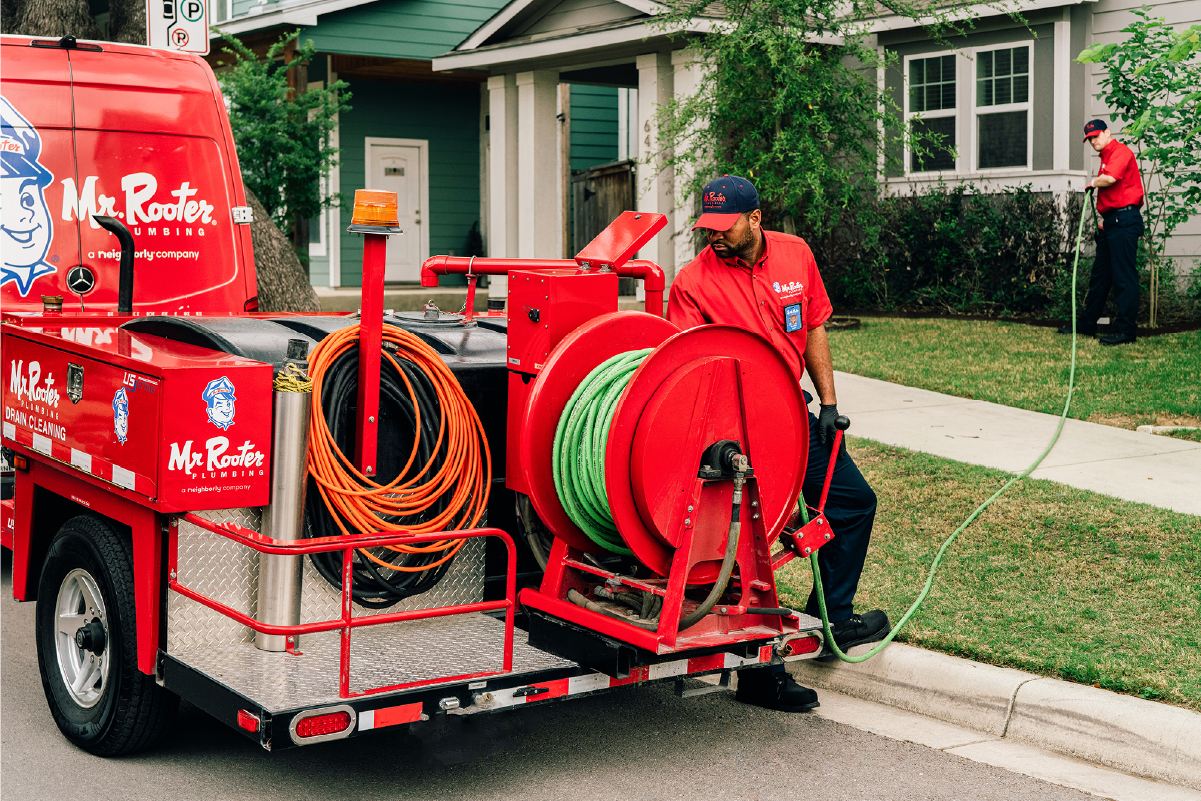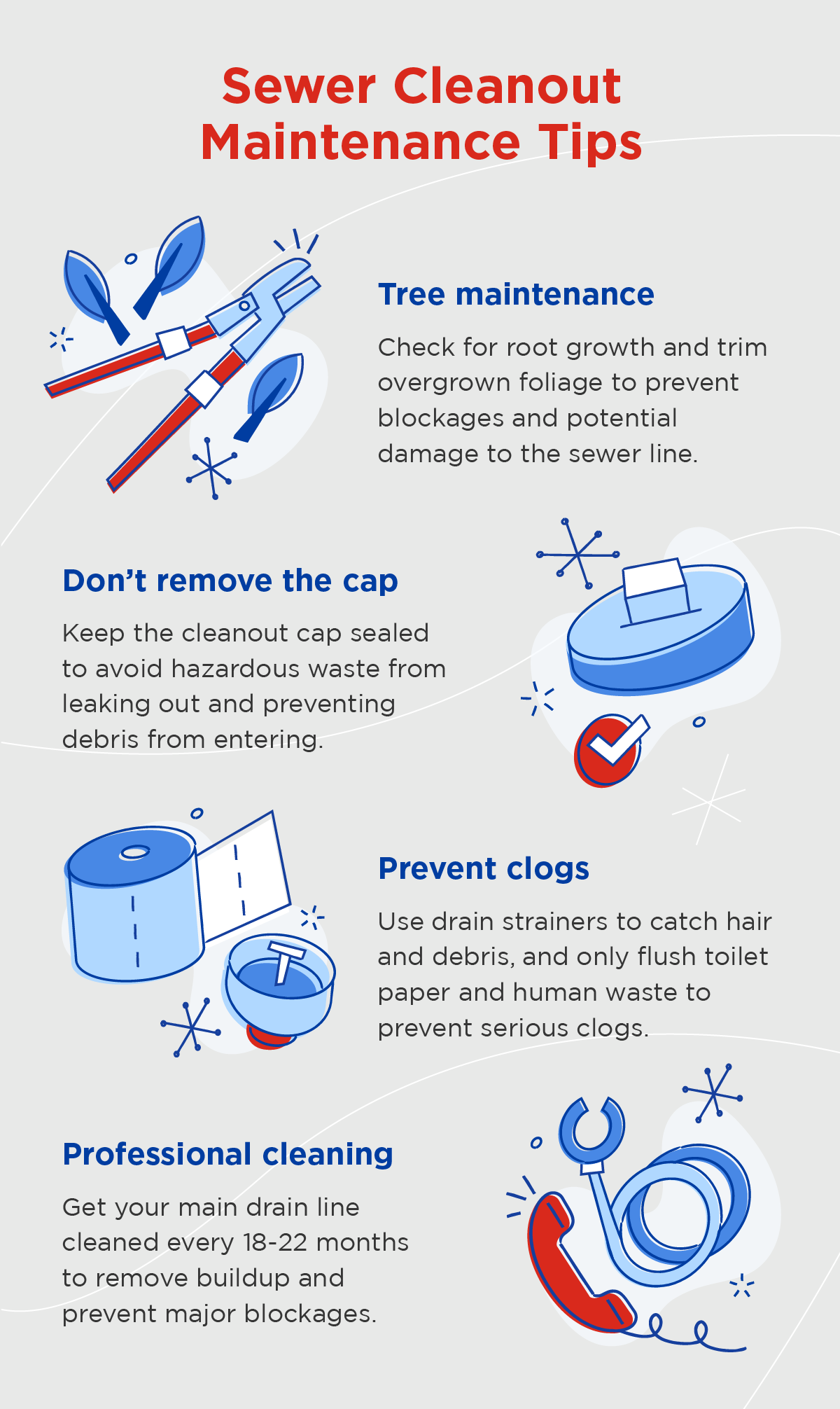
Mr. Rooter Plumbing explains how to locate a buried sewer cleanout for easy access during plumbing emergencies.
|
Imagine this: You’re washing dishes and find yourself dealing with a clogged kitchen sink. Later, your shower starts to back up and the water is slow to drain. Unfortunately, multiple clogged drains are a clear sign that there may be a bigger issue in your main sewer line.
The fix? Accessing the main drain line through your sewer cleanout to get to the root cause. Below, we’ll explain what a sewer cleanout is, where they’re located, and how you can maintain yours to prevent clogs in your sewer drain line.
What Is a Sewer Cleanout?
A sewer cleanout is the access point to your main sewage line — the pipe responsible for carrying household waste to the city sewer system or septic tank. Service professionals can easily clear clogs within the main sewer line via the cleanout, preventing blockages that could disrupt your home’s plumbing system.
Service professionals can also insert plumbing cameras into sewer cleanouts to inspect the main sewer line for damage, diagnose any issues, and determine the nature of a clog. A sewage cleanout consists of a pipe with a removable threaded cap. Removing the cap is how you can access the main sewage in your home.
Where Is the Sewer Cleanout?

The location of your cleanout depends on the size of your home and your local climate. In colder climates, the cleanout is most likely located inside the house near a bathroom, utility room, garage, or basement.
In warmer climates, the sewer cleanout is typically buried outside near the foundation of the home or along the property line. Homes built on a slab foundation may have an indoor cleanout to prevent water or sewage from flowing through the foundation.
How To Find a Buried Sewer Cleanout
To find a buried sewer cleanout, walk around the perimeter of your house, close to the foundation. A buried sewer cleanout is generally located on the outside of a bathroom. You’ll recognize it as a 3-to-4-inch capped pipe with a square or round head.
Since cleanouts aren’t needed often, yours may be covered by bushes, underbrush, or grass. It may also be concealed in a box close to the ground with a metal cover, so keep your eye out for anything that may contain a pipe.
Locating your buried sewer cleanout can also help you find your sewer line since the two are in line with each other. If you’re having trouble locating the cleanout, find your main sewer line or septic tank and walk in a line toward your house until you locate the capped pipe or ground box.
How To Find an Indoor Drain Cleanout
Indoor cleanouts are often located near a bathroom, utility room, or garage floor drain. If this is the case, it should be easy to spot, as it’s usually positioned directly next to the drain or just a few feet beside it.
However, some cleanouts may be harder to spot and require access to your home’s crawl space. To locate your sewer cleanout, follow the drain pipes that connect to your sink, tub, toilet, dishwasher, or other main plumbing fixture. The cleanout may be located where all of these pipes meet, capped with a metal or plastic knob.
Since following the pipes can be tricky if located behind walls or crawl spaces, it’s best to consult a service professional to help you locate the cleanout. If possible, you can also contact the previous owner of the home for more information on the cleanout’s whereabouts.
How To Maintain Your Sewer Cleanout

Proper cleanout maintenance is crucial in preventing backups in your main sewer line, ultimately preventing messy plumbing emergencies and potential damage. Here are a few tips for maintaining your drain cleanout.
- Maintain tree roots and foliage. Tree roots can grow into sewer lines through small cracks, causing blockages and potential damage. Grass and other foliage can also cover the cleanout, making it hard to spot and inspect. Regular maintenance of tree roots and overgrown foliage is key to preventing damage or problems with the sewer line.
- Don’t remove the cap. The cleanout should always remain capped and sealed to avoid hazardous waste from leaking out. Ensuring a proper seal can also prevent rainwater and other debris from entering the cleanout and causing backups. The cap should only be removed by a professional when they’re inspecting the cleanout.
- Prevent clogs. To prevent drain clogs, be mindful of what you’re putting down your drains. Practice good plumbing habits like using drain strainers to catch food debris or hair and only flushing toilet paper and human waste down the toilet. Stopping clogs from happening in the first place ensures you maintain your cleanout.
- Consider professional cleaning. Professional drain cleaning services help remove buildup and prevent major blockages. This is necessary to ensure your home’s plumbing system functions properly.
Prevent Sewer Clogs With Mr. Rooter Plumbing®
If you suspect you have a blockage in your main sewer line, do not attempt to fix it yourself. Damage to your sewer line can cause a toxic sewage backup in your home and result in expensive cleanup and repairs.
Mr. Rooter Plumbing has more than 45 years of experience dealing with plumbing emergencies like sewage blockages and can be trusted to solve your problem quickly and safely. With all work back by the Neighborly Done Right Promise®, Mr. Rooter Plumbing can clear even the toughest sewer blockage.
Give us a call or schedule an appointment online to see how we can help with your plumbing needs.
Sewer Cleanout FAQ
Still have questions? We’ve got answers to some common questions regarding sewer cleanouts.
How do you know if your sewer cleanout is clogged?
Experiencing multiple clogs simultaneously, smelling a foul sewage odor, or hearing gurgling noises in your pipes are all signs that your main sewer line may be backed up.
In some cases, sewage waste can be forced out of the cleanout if it isn’t sealed properly. This is a dangerous situation, as sewage is hazardous. Contact a service professional immediately to clear the clog.
How do you clear a sewer cleanout?
The best way to clear a sewer cleanout is to hire a service professional to do the job. They’ll be able to diagnose the root cause and complete a camera inspection to ensure there are no signs of damage within your main sewer line. They’ll also be able to offer advice on preventing future clogs from occurring.
How often should I clean my sewer line?
It’s recommended to have your main sewer line professionally cleaned every 18 to 22 months. However, this is a general guideline. A service professional can help you determine a cleaning cadence to ensure your main line stays clear and free of harmful buildup.
How many cleanouts does a house have?
A home usually has one main sewer cleanout, but some larger homes have an additional one. In rare cases, some older homes may not have a cleanout at all.

